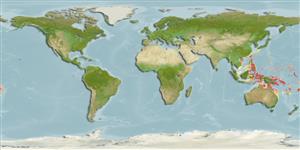Actinopterygii (ray-finned fishes) >
Perciformes (Perch-likes) >
Gobiidae (Gobies) > Gobiinae
Etymology: Trimma: Greek, trimma, -atos = something crushed (Ref. 45335); lantana: Named for the tropical plant, Lantana, the inflorescences of which is an assortment of yellow, orange, purple, and reddish-pink flowers, alluding to the colourful nature of this species and the rounded blotches on the head; noun in apposition.. More on author: Winterbottom.
Environment / Climate / Range
Ecology
Marine; demersal; depth range 5 - 30 m (Ref. 90102). Tropical, preferred ?
Distribution
Countries | FAO areas | Ecosystems | Occurrences | Point map | Introductions | Faunafri
Western Pacific: Australasian plate and the Solomon Islands.
Size / Weight / Age
Maturity: Lm ? range ? - ? cm
Max length : 2.9 cm SL male/unsexed; (Ref. 57688)
Dorsal
spines
(total): 7;
Dorsal
soft rays
(total): 7-9;
Anal
spines: 1;
Anal
soft rays: 5. Diagnosis: a frontal ridge behind the orbits that slopes steeply into a wide interorbital trench
anteromedially, and into postorbital trenches laterally; posterior nasal opening separate from anterior margin of eye; second spine of first dorsal elongate, third spine not elongate; fifth pelvic fin ray branched once dichotomously; body color on anterior half off-white, grey anteriorly with grey-blue snout, red-orange trunk grading to yellow caudally, with five white dorsolateral spots between peduncle and origin of first dorsal, and two white ventrolateral spots between the peduncle and anal fin; a red-orange bar and two irregular blotches under orbit; slightly darkened posterior margin of pectoral base (Ref. 57688).
Solitary, often resting on sand or rubble bottoms of caves and ledges in 5-30 m (Ref. 90102).
Life cycle and mating behavior
Maturity | Reproduction | Spawning | Eggs | Fecundity | Larvae
Winterbottom, R. and C.A. Villa, 2003. A new species of the Trimma caesiura species complex (Teleostei: Gobiidae) from the north-eastern margin of the Australian Plate, with a redescription of the other nominal species in the complex. Aqua, J. Ichthyol. Aquat. Biol. 7(1):13-28. (Ref. 57688)
IUCN Red List Status (Ref. 115185)
CITES (Ref. 94142)
Not Evaluated
Threat to humans
Harmless
Human uses
More information
CountriesFAO areasEcosystemsOccurrencesIntroductionsStocksEcologyDietFood itemsFood consumptionRation
Common namesSynonymsMetabolismPredatorsEcotoxicologyReproductionMaturitySpawningFecundityEggsEgg development
ReferencesAquacultureAquaculture profileStrainsGeneticsAllele frequenciesHeritabilityDiseasesProcessingMass conversion
Tools
Special reports
Download XML
Internet sources
